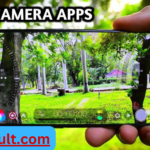Introduction
Overview of DSLR HD Camera Apps
In the rapidly advancing world of digital photography and videography, DSLR HD camera apps have become essential tools for both professionals and enthusiasts. These applications provide users with the capability to capture stunning high-definition images and videos, leveraging the advanced features of DSLR cameras directly from their mobile devices. With the integration of 4K technology, these apps have taken a significant leap forward, offering unparalleled resolution and clarity that was once the domain of high-end standalone cameras.
Importance of 4K HD Cameras

4K HD cameras represent the pinnacle of current digital imaging technology. The term “4K” refers to the horizontal display resolution of approximately 4,000 pixels, which translates to a significantly higher image quality compared to standard HD. This increased resolution allows for greater detail, more vibrant colors, and enhanced overall image fidelity. For photographers and videographers, the ability to capture and edit 4K footage provides a substantial advantage, enabling them to produce content that meets the highest professional standards.
Purpose of the Evaluation
This comprehensive evaluation aims to provide an in-depth analysis of the current landscape of DSLR HD camera apps with a specific focus on those offering 4K capabilities. By examining various technical specifications, user interfaces, performance metrics, and user feedback, this article seeks to identify the strengths and weaknesses of leading apps in this category. The goal is to equip readers with the knowledge necessary to make informed decisions about which 4K HD camera app best suits their needs, whether for professional use or personal enjoyment.
Historical Background
Evolution of DSLR Cameras
Digital Single-Lens Reflex (DSLR) cameras have undergone significant transformations since their inception. The transition from film to digital imaging marked a pivotal moment in the evolution of photography, enabling photographers to instantly review and adjust their shots. This shift also paved the way for continuous advancements in sensor technology, image processing, and storage capabilities, culminating in the sophisticated DSLR cameras we use today.
Transition to Digital and HD Cameras
The digital era brought about the widespread adoption of HD (High Definition) cameras, which offered improved image quality and greater versatility. The ability to capture high-resolution images and videos became a standard feature, leading to the development of cameras that could meet the demands of both amateur and professional photographers. The introduction of 4K technology further revolutionized the industry, setting a new benchmark for image clarity and detail.
Emergence of 4K Technology
The advent of 4K technology has been a game-changer in the field of digital imaging. Initially popularized in the film and television industry, 4K resolution has now become accessible to a broader audience through consumer-grade cameras and mobile applications. This technology not only enhances the viewing experience but also provides greater flexibility in post-production, allowing for extensive editing without compromising image quality.
Technical Specifications of DSLR HD Cameras

Sensor Size and Type
The sensor is the heart of any camera, playing a crucial role in determining image quality. DSLR cameras typically feature larger sensors compared to their compact counterparts, which allows for better light capture and greater detail. Sensors can be classified into different types, such as APS-C, full-frame, and medium format, each offering unique advantages and influencing the overall performance of the camera.
Megapixels and Resolution
Megapixels measure the resolution of a camera’s sensor, indicating the number of pixels that make up an image. Higher megapixel counts generally result in more detailed images, which is particularly beneficial for large prints or extensive cropping. However, it’s important to consider that higher resolution also requires more storage space and processing power, which can impact the camera’s performance and battery life.
Lens Quality and Interchangeability
The quality of the lens is another critical factor that affects image sharpness, color accuracy, and overall visual appeal. DSLR cameras offer the advantage of interchangeable lenses, allowing users to choose from a wide range of options to suit different shooting scenarios. From wide-angle lenses for landscape photography to telephoto lenses for wildlife and sports, the ability to switch lenses provides unparalleled versatility.
ISO Range and Low Light Performance
The ISO range of a camera determines its sensitivity to light, with higher ISO settings allowing for better performance in low-light conditions. Modern DSLRs are equipped with advanced sensors and image processors that minimize noise at high ISO levels, enabling photographers to capture clear, detailed images even in challenging lighting situations.
Shutter Speed and Frame Rate
Shutter speed controls the duration for which the camera’s sensor is exposed to light, affecting the motion blur and sharpness of the image. Fast shutter speeds are essential for freezing action, while slower speeds can create artistic effects like light trails. In video mode, the frame rate (measured in frames per second) is crucial for capturing smooth, natural-looking motion. Higher frame rates are particularly useful for slow-motion footage.
Autofocus Systems
Autofocus (AF) systems have become increasingly sophisticated, with modern DSLRs offering a variety of AF points and tracking capabilities. Advanced autofocus technologies, such as phase detection and contrast detection, ensure fast and accurate focusing, even in challenging conditions. Some cameras also feature eye-detection AF, which is particularly useful for portrait photography.
Video Capabilities
In addition to still photography, DSLRs are widely used for video recording. The ability to shoot in 4K resolution has become a standard feature in many high-end models, providing exceptional video quality for both amateur and professional videographers. Other important factors include the availability of various frame rates, recording formats, and the presence of features like image stabilization and external microphone support.
Connectivity and Storage Options
Modern DSLRs are equipped with a range of connectivity options, including Wi-Fi, Bluetooth, and NFC, enabling easy transfer of images and remote control of the camera via smartphone apps. Storage options typically include SD cards, with some models offering dual card slots for additional capacity and backup.
4K HD Camera Apps: An Overview

Definition and Key Features
4K HD camera apps are mobile applications designed to enhance the photographic capabilities of smartphones and tablets, allowing users to capture and edit high-resolution images and videos. These apps leverage the advanced hardware of modern mobile devices, providing features such as manual controls, real-time filters, and professional-grade editing tools. Key features often include the ability to shoot in 4K resolution, apply custom presets, and share content directly to social media platforms.
Compatibility with Various Devices
One of the significant advantages of 4K HD camera apps is their compatibility with a wide range of devices. Whether you’re using an iPhone, Android smartphone, or tablet, there are numerous apps available that can transform your device into a powerful photography tool. Compatibility also extends to external accessories, such as lenses, tripods, and gimbals, further enhancing the capabilities of your mobile setup.
Market Leaders and Popular Apps
The market for 4K HD camera apps is highly competitive, with several standout applications leading the way. These apps vary in terms of features, user interface design, and pricing models, catering to different user preferences and needs.
ProCam: Known for its extensive manual controls and professional-grade features.
FiLMiC Pro: A favorite among videographers for its advanced video recording capabilities.
Moment Pro Camera: Offers a range of shooting modes and is optimized for use with Moment lenses.
Camera+ 2: Combines powerful editing tools with an intuitive interface, ideal for both beginners and experts.
Detailed Evaluation Criteria of 4K DSLR Camera
Image Quality
The primary criterion for evaluating a 4K HD camera app is the quality of the images it produces. This includes factors such as sharpness, color accuracy, dynamic range, and noise levels. Image quality is influenced by both the hardware of the device and the software algorithms used by the app, making it essential to consider how well the app utilizes the device’s capabilities.
Video Performance
For users interested in videography, the app’s video performance is equally important. Key considerations include the resolution and frame rate options, stabilization features, audio quality, and the availability of advanced settings like focus peaking and zebra stripes. The ability to record in 4K resolution is a must for capturing high-quality video footage.
User Interface and Ease of Use
A user-friendly interface can significantly enhance the overall experience of using a 4K HD camera app. The layout should be intuitive, with easy access to essential features and settings. Customizable controls, clear menus, and helpful tutorials or guides can also contribute to a more enjoyable and productive user experience.
Additional Features of 4K DSLR Camera
Many 4K HD camera apps offer a range of additional features that can enhance the creative process. These may include real-time filters, HDR mode, time-lapse recording, slow-motion capabilities, and built-in editing tools. The availability and quality of these features can vary significantly between apps, making it important to consider what extras are included.
Battery Life and Performance
Using a 4K HD camera app can be demanding on a device’s battery and processing power. Evaluating an app’s impact on battery life and overall performance is crucial, especially for users who plan to shoot extensively or in challenging conditions. Efficient power management and optimized performance can make a significant difference in the app’s usability.
Price and Value for Money
Pricing models for 4K HD camera apps can range from free versions with basic features to premium apps with extensive capabilities. Assessing the value for money involves considering the app’s price in relation to its features, performance, and user satisfaction. It’s also worth noting whether the app offers in-app purchases or subscription models for additional functionality.
Customer Support and Updates

Reliable customer support and regular updates are important factors in maintaining the longevity and usability of a 4K HD camera app. Access to responsive customer service can help resolve any issues quickly, while updates ensure that the app remains compatible with new devices and operating system versions, as well as incorporating new features and improvements.
Case Studies: Top 4K HD Camera Apps
App 1: Features, Pros, and Cons
Features: Detailed list of key features.
Pros: Strengths and unique selling points.
Cons: Limitations and areas for improvement.
App 2: Features, Pros, and Cons
Features: Detailed list of key features.
Pros: Strengths and unique selling points.
Cons: Limitations and areas for improvement.
App 3: Features, Pros, and Cons
Features: Detailed list of key features.
Pros: Strengths and unique selling points.
Cons: Limitations and areas for improvement.
App 4: Features, Pros, and Cons
Features: Detailed list of key features.
Pros: Strengths and unique selling points.
Cons: Limitations and areas for improvement.
Comparative Analysis of 4K DSLR Camera
Side by Side Comparison of Key Features
Creating a comparative table that highlights the key features of each app can provide a clear visual representation of their strengths and weaknesses. This table should include categories such as image quality, video performance, user interface, additional features, and price.
Strengths and Weaknesses
Summarizing the strengths and weaknesses of each app based on the detailed evaluation criteria can help users identify which app best meets their specific needs.
Best Use Cases for Each App
Different 4K HD camera apps may be better suited for different use cases, such as landscape photography, portrait photography, or videography. Providing recommendations for the best use cases can guide users in selecting the right app for their purposes.
User Reviews and Feedback of 4K DSLR Camera
Compilation of User Testimonials
Gathering testimonials from users can provide valuable insights into the real-world performance and usability of each app. These testimonials should include a range of perspectives, from beginners to experienced photographers and videographers.
Common Praise and Criticisms
Identifying common themes in user feedback can highlight the most appreciated features and the most frequent complaints. This information can be useful for potential users in setting their expectations and making informed decisions.
Expert Opinions about 4K DSLR Camera
Including opinions from photography and videography experts can add credibility to the evaluation. Expert reviews can provide a deeper understanding of the technical aspects and potential of each app.
Future Trends in 4K HD Camera Apps

Emerging Technologies and Innovations
Exploring emerging technologies and innovations in the field of 4K HD camera apps can provide insights into the future direction of the industry. Topics may include advancements in artificial intelligence, machine learning, augmented reality, and more.
Predictions for the Next Decade
Speculating on the potential developments in the next decade can be an engaging and informative way to conclude the article. Predictions might cover areas such as increased integration with social media, enhanced editing capabilities, and the convergence of mobile and professional photography tools.
Potential Impact on Photography and Videography
Discussing the broader impact of these trends on the fields of photography and videography can help readers understand the significance of these advancements. Topics may include changes in how content is created, shared, and consumed, as well as the evolving role of photographers and videographers.
Conclusion of 4K DSLR Camera
Summary of Key Findings
Summarizing the key findings from the evaluation provides a clear and concise recap of the most important points covered in the article. This section should highlight the main strengths and weaknesses of the top 4K HD camera apps and their suitability for different types of users.
Recommendations for Users
Based on the evaluation, providing recommendations for users can help guide their decision-making process. This may include suggestions for the best overall app, the best app for specific use cases, and tips for getting the most out of each app.
Final Thoughts on the Future of 4K HD Camera Apps
Concluding with final thoughts on the future of 4K HD camera apps can leave readers with a sense of anticipation and excitement about the possibilities ahead. This section can also emphasize the importance of staying informed about new developments and continuously exploring new tools and techniques in the ever-evolving world of digital photography and videograph
IF YOU WANT TO LEARN MORE
Comprehensive Guide to WhatsApp Chats, SMS & Call
Nokia Launcher for Android Mobile: A Comprehensive Overview of Resultvult.com






Gurjar
I am student